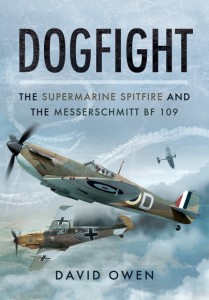The title of this book suggests that it is primarily written for pilots. But if you buy the book for that, than you get it wrong. This book is the most elaborate ‘air war history book’ that I have ever laid my hands on. It starts off in the after days of WO I and ‘flies’ on into the Korean War. Almost all airplane types of the on British and German side ‘along flying.’ Nations (striking exception: Fokker) are technically as well as operationally described with great detail. Also the designers of the airplanes and the power play in which they managed to bring their design to series construction, is extensively set out.
Something for everybody, David Owen must have thought, when he wrote this book. The consequence is that you will have to read this book selectively, else you will submerge in less concerning details. Central are the in the title mentioned Spitfire and BG 109. Which alone are already unique because they each, with adaptations, stayed top class jet fighters during WO II. These designs were so evenly matched that it really depended on the quality of the pilot who survived a dogfight.
As my personal interest particularly goes out to war history, I have focussed on those chapters in the book. Interesting is for example the story about the German involvement with the Spanish civil war. The Germans got there the chance to test their spick and span new BF 109, with 2 bladed wooden propeller, against the newest Soviet jet fighter, the Polikarpov I-16. Quickly it became clear that not only the plane but also the operational deploy of it, made the difference. Werner Mölders made here the step from the Kette to the Rotte. This was the letting go of rigid formation flying, by which the wing man had to follow his leader, to a much more loose formation, by which watching around for attackers was the main task. That lesson did give the Germans a lot of advantages, especially in the beginning of the Battle of Britain compared to the, initially still in rigid formation flying, British.
A sidestep to technique. In the BF 109 the pilot sat, because of the highly placed feet lever, higher with his legs compared to his buttocks, than his colleagues in a Spitfire. That delivered better G-force sustainability for the BF 109 pilot! The further developments of both main characters, but also of many other important airplane types, like the Focke Wulf 110 and the North American P 51, are broadly set out, as well in the technical sense as the operational deploy. Also, the men who brought forward the ideas for improvements and the final deciders, are mentioned. Looking in retrospect, it becomes clear that not every adjustment was an improvement. The war business is a merciless school! The book, decorated with a lot of fascinating picture material, makes it an attractive one to get your hands on. For the price of GBP 25.- (USD 44,95), it may just be that. All in all a book that is hard to put down once you have started in it!












Leave a Reply